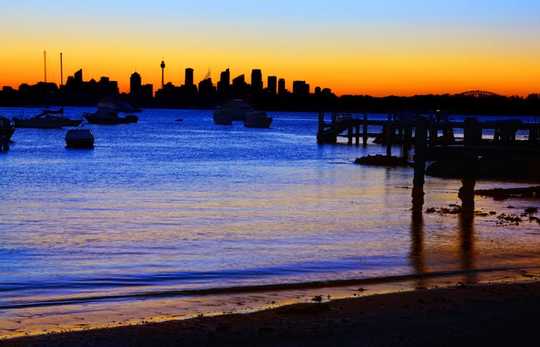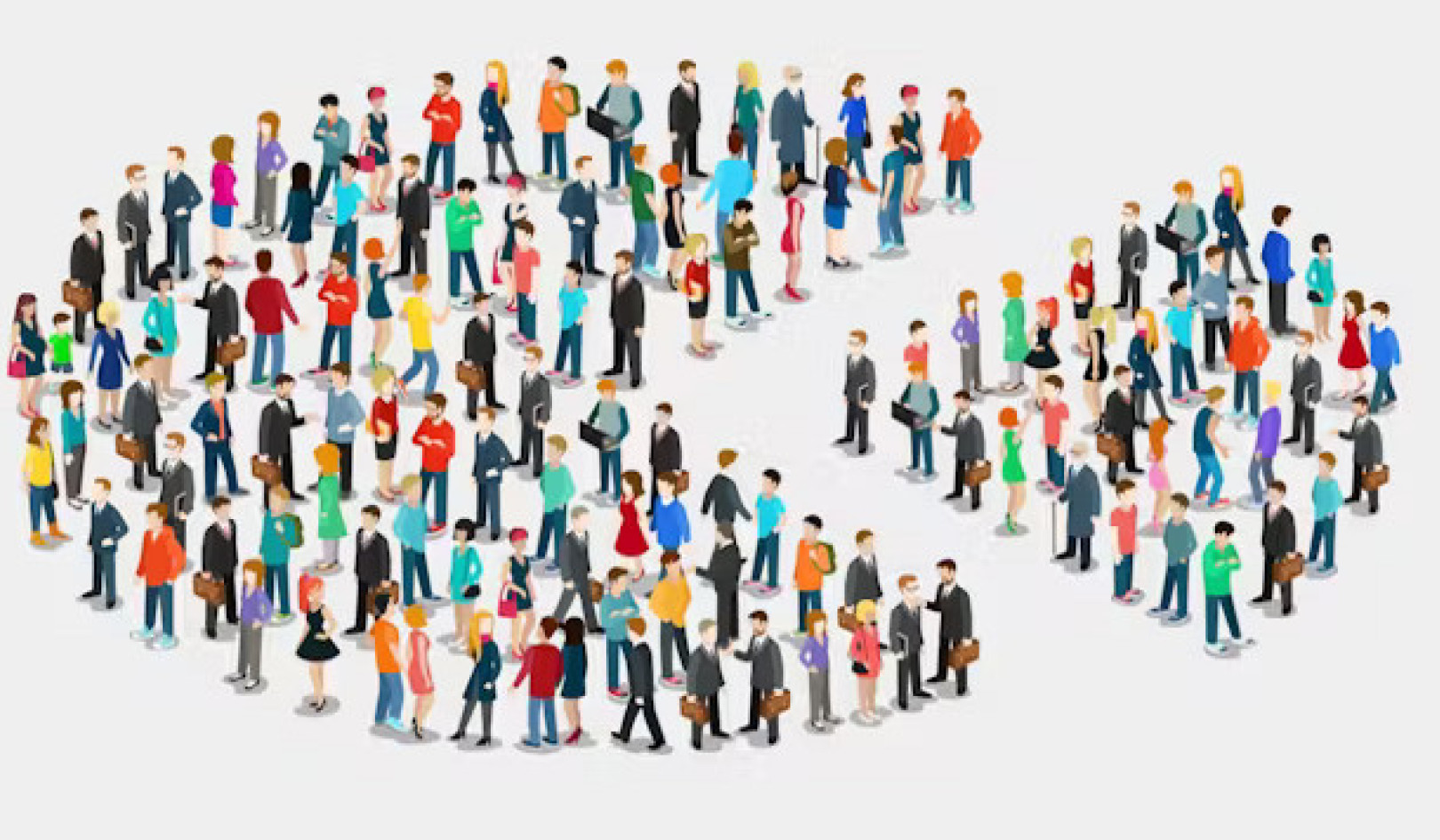
Cities are facing more heatwaves, but not all strategies to keep us cool are equal. image of Sydney from www.shutterstock.com
The recent spate of heatwaves through eastern Australia has reminded us we’re in an Australian summer. On top of another record hot year globally, and as heatwaves become more frequent and intense, our cities are making us even hotter.
This is the urban heat island, where city temperatures can be significantly warmer than the surrounding rural regions.
The question, then, is what we can do to keep our cities cooler.
Why are cities hotter?
The temperature difference is caused by a range of factors, including dense building materials absorbing more of the sun’s energy, fewer trees to provide shade, and less soil to cool by evaporation.
Buildings can also act like the hairs on a husky, reducing wind speeds and blocking thermal radiation up to the night sky. On top of that, waste heat from car engines, air-conditioners and other energy use adds to overall air temperatures.
Why does this matter? Even a small increase in air temperature pushes up overall energy demand, and about 25% of our energy bills are for only 40 hours per year when the grid is most heavily used.
The most extreme heat events can buckle train lines, cause rolling blackouts and cost billions in lost productivity. And it’s not just bad for our wallets.
Heat stress can damage organs or exacerbate existing illnesses. Since 1900, extreme heat events have killed more Australians than bushfires, cyclones, earthquakes, floods and severe storms combined.
So, what can we do?
There are a number of things individuals can do to reduce the impact of heat in their homes, such as installing light coloured roofing material, insulation or an air-conditioner.
But it gets more complicated when considering the city as a whole, and how these small actions interact with each other and with the climate.
Air-conditioners
In heatwaves, air-conditioners save lives, allowing stressed bodies time to cool. But our homes can only be made cooler by blowing heat outside, along with the extra energy to run the system.
As well as increasing outside air temperatures in the short term, the fossil fuels burned add to global warming. A world cooled by air-conditioning probably isn’t the answer.
Trees and parks
Trees provide shade, but also cool the air, because evaporating water from leaves takes energy, reducing peak temperatures by 1-5° C.
Most city planners agree on the broad benefits of urban vegetation, with some metropolitan councils developing urban greening strategies.
However, urban trees can be a vexed issue for some councils; they use water, can be costly to maintain, can damage utilities and property, and can worsen air quality instead of improving it. Larger cities are often made up of dozens of councils; getting them to agree is a major challenge.
White roofs
We know that black surfaces get hotter in the sun, but demand for dark roof tiles still far outweighs demand for light colours. More reflective roofs can reduce a household’s energy bill, as well as the overall temperature of a city.
White roofs are most effective in warmer climates, because in cold climates, the cost savings in summer must be balanced with additional heating costs in winter.
Green roofs and walls
Green roofs and walls are building structures with integrated vegetation. They provide cooling benefits by shading buildings and through evaporation from leaves. They generally show less cooling benefit than white roofs, cost more to install and maintain, and use additional water and energy.
But they do look nice, improve biodiversity and make people happier.
Pavement watering
Prior to an extreme heatwave, it may be possible to reduce temperatures by wetting down building and road surfaces. It’s a traditional practice in Japan, and is now being considered in major cities like Paris.
But temperature and humidity are important factors in heat stress, so pavement watering should only be undertaken if the extra humidity does not increase heat stress.
Large scale rooftop solar
Solar panels convert energy from the sun into electricity, so less energy is required from the network overall. If enough roofs were covered with solar panels, could that lower air temperatures?
Probably a little. Other benefits include a reduction in the energy required for cooling (because the roofs are shaded by panels), and a stable, lower cost, decentralised renewable energy system.
Building density
A building with lots of thermal mass (think sturdy, double-brick home) can be an effective way to keep inside temperatures more stable. Heat is absorbed during the day and released at night. The same idea can work for an entire city.
An urban cool island can form in high-density cities like Hong Kong because tall buildings provide extra heat capacity and shade.
For similar reasons, the tight street layout of traditional Arabian and Mediterranean cities keep those streets cooler.
Shading structures
Installing light shading structures over streets, pavements and roofs can reduce the surface temperature of materials, and reduce the heat absorbed and radiated back into streets. Shading structures need to be designed so that they do not limit airflow, trapping heat and air pollution in streets.
Which is best?
To figure out what works best, we need to be able to model the physics of different strategies, in different types of cities and in different climates. We can then assess the economic and health impacts and decide on appropriate and plans that give us the biggest bang for our buck.
Here we have focused on heat in cities, but there are other important concerns like air quality or flooding.
In colder cities, an urban heat island could actually be a good thing. Each city is different; each requires a tailored and integrated plan developed over the entire metropolitan region, and then implemented locally by councils, businesses and households.![]()
About the Authors
Mathew Lipson, PhD Candidate, UNSW and Melissa Hart, Graduate Director ARC Centre of Excellence for Climate System Science, UNSW
This article is republished from The Conversation under a Creative Commons license. Read the original article.
Related Books
Climate Adaptation Finance and Investment in California
by Jesse M. Keenan This book serves as a guide for local governments and private enterprises as they navigate the unchartered waters of investing in climate change adaptation and resilience. This book serves not only as a resource guide for identifying potential funding sources but also as a roadmap for asset management and public finance processes. It highlights practical synergies between funding mechanisms, as well as the conflicts that may arise between varying interests and strategies. While the main focus of this work is on the State of California, this book offers broader insights for how states, local governments and private enterprises can take those critical first steps in investing in society’s collective adaptation to climate change. Available On Amazon
This book serves as a guide for local governments and private enterprises as they navigate the unchartered waters of investing in climate change adaptation and resilience. This book serves not only as a resource guide for identifying potential funding sources but also as a roadmap for asset management and public finance processes. It highlights practical synergies between funding mechanisms, as well as the conflicts that may arise between varying interests and strategies. While the main focus of this work is on the State of California, this book offers broader insights for how states, local governments and private enterprises can take those critical first steps in investing in society’s collective adaptation to climate change. Available On Amazon
Nature-Based Solutions to Climate Change Adaptation in Urban Areas: Linkages between Science, Policy and Practice
by Nadja Kabisch, Horst Korn, Jutta Stadler, Aletta Bonn This open access book brings together research findings and experiences from science, policy and practice to highlight and debate the importance of nature-based solutions to climate change adaptation in urban areas. Emphasis is given to the potential of nature-based approaches to create multiple-benefits for society.
This open access book brings together research findings and experiences from science, policy and practice to highlight and debate the importance of nature-based solutions to climate change adaptation in urban areas. Emphasis is given to the potential of nature-based approaches to create multiple-benefits for society.
The expert contributions present recommendations for creating synergies between ongoing policy processes, scientific programmes and practical implementation of climate change and nature conservation measures in global urban areas. Available On Amazon
A Critical Approach to Climate Change Adaptation: Discourses, Policies and Practices
by Silja Klepp, Libertad Chavez-Rodriguez This edited volume brings together critical research on climate change adaptation discourses, policies, and practices from a multi-disciplinary perspective. Drawing on examples from countries including Colombia, Mexico, Canada, Germany, Russia, Tanzania, Indonesia, and the Pacific Islands, the chapters describe how adaptation measures are interpreted, transformed, and implemented at grassroots level and how these measures are changing or interfering with power relations, legal pluralismm and local (ecological) knowledge. As a whole, the book challenges established perspectives of climate change adaptation by taking into account issues of cultural diversity, environmental justicem and human rights, as well as feminist or intersectional approaches. This innovative approach allows for analyses of the new configurations of knowledge and power that are evolving in the name of climate change adaptation. Available On Amazon
This edited volume brings together critical research on climate change adaptation discourses, policies, and practices from a multi-disciplinary perspective. Drawing on examples from countries including Colombia, Mexico, Canada, Germany, Russia, Tanzania, Indonesia, and the Pacific Islands, the chapters describe how adaptation measures are interpreted, transformed, and implemented at grassroots level and how these measures are changing or interfering with power relations, legal pluralismm and local (ecological) knowledge. As a whole, the book challenges established perspectives of climate change adaptation by taking into account issues of cultural diversity, environmental justicem and human rights, as well as feminist or intersectional approaches. This innovative approach allows for analyses of the new configurations of knowledge and power that are evolving in the name of climate change adaptation. Available On Amazon
From The Publisher:
Purchases on Amazon go to defray the cost of bringing you InnerSelf.comelf.com, MightyNatural.com, and ClimateImpactNews.com at no cost and without advertisers that track your browsing habits. Even if you click on a link but don't buy these selected products, anything else you buy in that same visit on Amazon pays us a small commission. There is no additional cost to you, so please contribute to the effort. You can also use this link to use to Amazon at any time so you can help support our efforts.






















